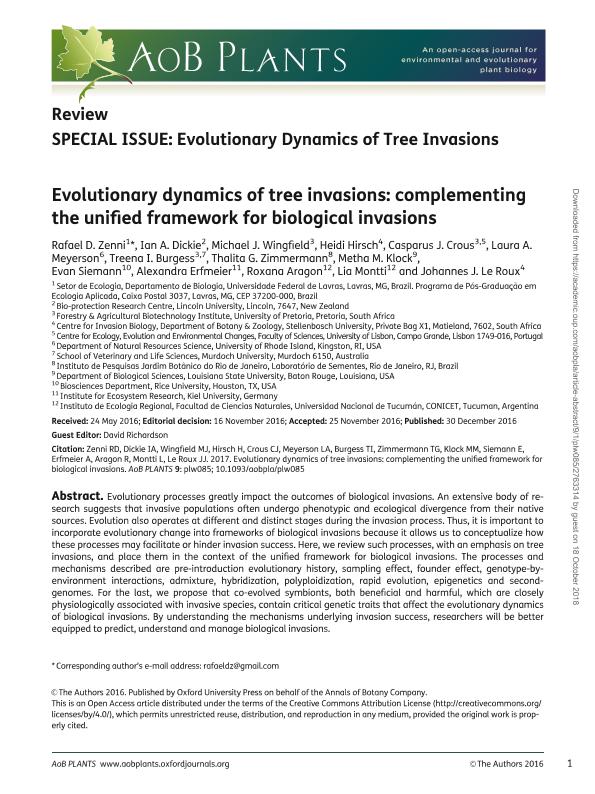Mostrar el registro sencillo del ítem
dc.contributor.author
Zenni, Rafael D.
dc.contributor.author
Dickie, Ian A.
dc.contributor.author
Wingfield, Michael J.

dc.contributor.author
Hirsch, Heidi
dc.contributor.author
Crous, Casparus J.
dc.contributor.author
Meyerson, Laura A.
dc.contributor.author
Burgess, Treena I.
dc.contributor.author
Zimmermann, Thalita G.
dc.contributor.author
Klock, Metha M.
dc.contributor.author
Siemann, Evan
dc.contributor.author
Erfmeier, Alexandra
dc.contributor.author
Aragón, Myriam Roxana

dc.contributor.author
Montti, Lia Fernanda

dc.contributor.author
Le Roux, Johannes

dc.date.available
2018-10-18T14:43:39Z
dc.date.issued
2017-01
dc.identifier.citation
Zenni, Rafael D.; Dickie, Ian A.; Wingfield, Michael J.; Hirsch, Heidi; Crous, Casparus J.; et al.; Evolutionary dynamics of tree invasions: Complementing the unified framework for biological invasions; Oxford University Press; AoB PLANTS; 9; 1; 1-2017; 1-14
dc.identifier.issn
2041-2851
dc.identifier.uri
http://hdl.handle.net/11336/62688
dc.description.abstract
Evolutionary processes greatly impact the outcomes of biological invasions. An extensive body of research suggests that invasive populations often undergo phenotypic and ecological divergence from their native sources. Evolution also operates at different and distinct stages during the invasion process. Thus, it is important to incorporate evolutionary change into frameworks of biological invasions because it allows us to conceptualize how these processes may facilitate or hinder invasion success. Here, we review such processes, with an emphasis on tree invasions, and place them in the context of the unified framework for biological invasions. The processes and mechanisms described are pre-introduction evolutionary history, sampling effect, founder effect, genotype-byenvironment interactions, admixture, hybridization, polyploidization, rapid evolution, epigenetics and secondgenomes. For the last, we propose that co-evolved symbionts, both beneficial and harmful, which are closely physiologically associated with invasive species, contain critical genetic traits that affect the evolutionary dynamics of biological invasions. By understanding the mechanisms underlying invasion success, researchers will be better equipped to predict, understand and manage biological invasions.
dc.format
application/pdf
dc.language.iso
eng
dc.publisher
Oxford University Press
dc.rights
info:eu-repo/semantics/openAccess
dc.rights.uri
https://creativecommons.org/licenses/by-nc-sa/2.5/ar/
dc.subject
Contemporary Evolution
dc.subject
Epigenetics
dc.subject
Evolution
dc.subject
Genetic Variation
dc.subject
Invasion Biology
dc.subject
Second-Genome
dc.subject
Tree Invasions
dc.subject.classification
Otras Ciencias Biológicas

dc.subject.classification
Ciencias Biológicas

dc.subject.classification
CIENCIAS NATURALES Y EXACTAS

dc.title
Evolutionary dynamics of tree invasions: Complementing the unified framework for biological invasions
dc.type
info:eu-repo/semantics/article
dc.type
info:ar-repo/semantics/artículo
dc.type
info:eu-repo/semantics/publishedVersion
dc.date.updated
2018-10-01T15:26:24Z
dc.journal.volume
9
dc.journal.number
1
dc.journal.pagination
1-14
dc.journal.pais
Reino Unido

dc.journal.ciudad
Oxford
dc.description.fil
Fil: Zenni, Rafael D.. Universidade Federal de Lavras; Brasil
dc.description.fil
Fil: Dickie, Ian A.. Lincoln University, New Zealand;
dc.description.fil
Fil: Wingfield, Michael J.. Universiteit Van Pretoria; Sudáfrica
dc.description.fil
Fil: Hirsch, Heidi. Stellenbosch University; Sudáfrica
dc.description.fil
Fil: Crous, Casparus J.. Universidade de Lisboa; Portugal. Universiteit of Pretoria; Portugal
dc.description.fil
Fil: Meyerson, Laura A.. University Of Rhode Island; Reino Unido
dc.description.fil
Fil: Burgess, Treena I.. Murdoch University; Australia. Universiteit of Pretoria; Portugal
dc.description.fil
Fil: Zimmermann, Thalita G.. Instituto de Pesquisas Jardim Botanico Do Rio de Janerio; Brasil
dc.description.fil
Fil: Klock, Metha M.. Louisiana State University; Estados Unidos
dc.description.fil
Fil: Siemann, Evan. Rice University; Estados Unidos
dc.description.fil
Fil: Erfmeier, Alexandra. Kiel University; Alemania
dc.description.fil
Fil: Aragón, Myriam Roxana. Universidad Nacional de Tucumán. Instituto de Ecología Regional. Consejo Nacional de Investigaciones Científicas y Técnicas. Centro Científico Tecnológico Conicet - Tucumán. Instituto de Ecología Regional; Argentina
dc.description.fil
Fil: Montti, Lia Fernanda. Universidad Nacional de Tucumán. Instituto de Ecología Regional. Consejo Nacional de Investigaciones Científicas y Técnicas. Centro Científico Tecnológico Conicet - Tucumán. Instituto de Ecología Regional; Argentina
dc.description.fil
Fil: Le Roux, Johannes. Stellenbosch University; Sudáfrica
dc.journal.title
AoB PLANTS
dc.relation.alternativeid
info:eu-repo/semantics/altIdentifier/doi/https://dx.doi.org/10.1093/aobpla/plw085
dc.relation.alternativeid
info:eu-repo/semantics/altIdentifier/url/https://academic.oup.com/aobpla/article/9/1/plw085/2763314
Archivos asociados
